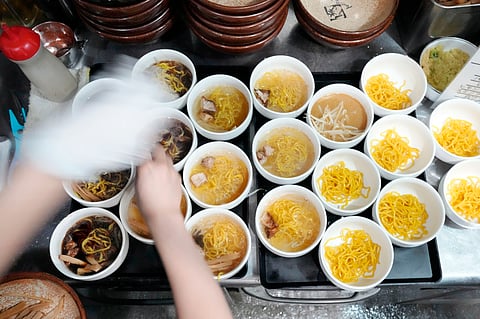
- LIFESTYLE
- FASHION
- FOOD
- ENTERTAINMENT
- EVENTS
- CULTURE
- VIDEOS
- WEB STORIES
- GALLERIES
- GADGETS
- CAR & BIKE
- SOCIETY
- TRAVEL
- NORTH EAST
- INDULGE CONNECT

Spicy, steaming, slurpy ramen might be everyone’s favorite Japanese food. In Tokyo, long lines circle around blocks, and waiting an hour for your ramen is normal. What awaits might be just a dive, but a hot bowl of ramen rarely fails to hit the spot.
Often cooked right before your eyes behind dingy counters, the noodle dish starts here at around 1,000 yen (USD 6.50), and comes in various flavors and local versions. There's salty, soy-based Shoyu or miso paste. Perhaps it's red-hot spicy with a dash of chili. Sometimes there's no soup at all but a sauce to dip the noodles in. The curly noodles are lighter than the darker buckwheat soba, or udon, which are also usually flatter or thicker.
Some Japanese frequent ramen shops twice or three times a week. They emerge, dripping with sweat, smacking their lips. “I’m probably a talking bowl of ramen,” says Frank Striegl as he leads a dozen American tourists through the back alleys of Tokyo’s funky Shibuya district on what he calls “the ultimate ramen experience.”
The crowd is led behind a shabby doorway, sometimes down narrow stairs, to a dim-lit table where ramen gets served in tiny bowls, practically the size of a latte cup, or about a quarter of a regular ramen bowl. That's so guests have enough room in their tummies to try out six different kinds of ramen, two at each spot during the tour.
One restaurant, Shinbusakiya, offers “Hokkaido classics” from the northernmost main island, while another, Nagi, offers “Fukuoka fusion,” from the southern main island of Kyushu. It includes a green ramen, similar to pasta al pesto. Syuuichi, which means “once a week,” features curry-flavored ramen.
“It’s not just, of course, about eating delicious ramen, but also learning about it,” said Striegl, a Filipino American who grew up in Tokyo. He calls ramen “people’s food.”
“A lot of countries around the world have their version of ramen in a way," he said. "So I think because of that, it’s a dish that’s easy to understand. It’s a dish that’s easy to get behind.”
While the tour participants were relishing their noodles, Striegl outlined a brief history of ramen: Its roots date back to the samurai era, when a shogun took a fancy to Chinese noodles, setting off the localising journey for ramen that continues today.
Katie Sell, a graduate student on Striegl’s tour, called ramen "a kind of comfort food, especially in the winter. Get a group of friends, go have some ramen and just enjoy it.”
While ramen has never been more popular in Japan, ramen places have struggled because of the pandemic, the weakening Japanese yen, and the higher cost of wheat imports and energy, according to a study. One beneficiary of the pandemic is a home delivery service for frozen, professionally cooked ramen.
Besides the different soup stocks and flavors, onions, grated garlic, ginger or sesame oil can be added for extra punch. Toppings can include bean sprouts, barbecued pork, boiled or raw eggs, seaweed, fermented bamboo shoots called menma, chopped green onions, cooked cabbage, snow peas or corn. Some insist a bowl of ramen is not complete without a slice of narutomaki, a whitefish cake with a pink spiral pattern.
Unusual varieties include coffee ramen and ramen topped with ice cream or pineapple. Jiro-style ramen, named for a legendary restaurant in Tokyo, features mounds of vegetable toppings, huge steak-like barbecued pork and pungent, grated garlic seeped in a fatty pork-based stock.
“Impact is important. So the pork has to be big so it’s truly memorable,” said Kota Kobayashi, who serves Jiro-style ramen at his chain, “Ore No Ikiru Michi,” which translates to, “The way I live my life.”
Kobayashi is a former professional baseball player at the Yokohama Bay Stars, and played with the minor league Cleveland Guardians before switching to his ramen business. “When I quit baseball, I chose ramen as my way of life,” he said with a smile.
And taste is only part of what makes good ramen. One must also offer entertainment, Kobayashi said.
At his restaurants, the chopsticks are tucked in a box on a shelf, so first-time visitors ask where they are. Repeat customers go straight to that box. Kobayashi calls out, “Welcome back,” making the customers feel a connection, even if he doesn't remember a thing about them.